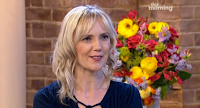This Morning has been hugely popular and has been running on UK television since October 1988. It contains an array of highly relevant topical items, showbiz gossip and even real life features. The show airs week days between 10:30 -12:30 and must be doing something right to capture viewers.
Apart from the stories and guests involved a lot of work goes into the camera work that is so technical, it goes un-noticed.
The example that I have chosen to analyse can be found by clicking here.
The picture above shows what is expected from most daytime talk shows, especially those on ITV, the titles. The titles are the first thing seen on the screen which open the show.
The first shot the viewer is presented with is a mid-shot of the two presenters. This is to give the viewer a clear view of who the presenters of the show are going to be. Even though the viewer knows who to expect, it acts as a comfort to them. It is also something a lot of viewers like and feel comfortable with.
Once the presenter(s) have introduced the show they will start to introduce the first guest. Whilst the guests are being introduced it is very typical that a VT or still from a newspaper or magazine, is shown to the viewer. This is done to make the viewer feel involved with what the guest is about to be interviewed on, even if they have no idea who they are. It is a very clever, yet easy technique which stops viewers from switching off.
When looking at camera angles in particular I noticed a certain trend. Once the guest has been welcomed a close up shot on them stays for roughly 4-5 seconds, this gives the viewer the opportunity to familiarise themselves with who is on screen. Typically mid-shots are used the most to capture any emotion that may be provoked by questions asked.
Another shot that is quite often seen is a mid-long shot of those that are sat next to or quite close to each-other. This establishes the interviewee's exact location in comparison to others and answers any questions of who they may be looking at whilst talking. Another reason this is used is to break up the pace of the interview as it could become very boring if the camera literally switched between interviewer and interviewee.
As you can see quite clearly in the two pictures above, when the interviewer and interviewee are in direct conversation the shot type stays the same, which in this example is mid-shot. The 180 degree rule is also followed to show the flow and effect of the conversation that is taking place. Without this the editing technique the viewer would feel un-orientated and the whole thing could become confusing if the viewer is not paying full attention.
Long and extreme long shots are also used in daytime talk shows to establish to the viewer the atmosphere in which the interview is taking place. It also confirms to the viewer that the guests are in the same room as those interviewing.
These varied shot types are highly effective in ensuring that the viewer does not loose interest and are made to feel as if they are in the room as it is taking place.
The recording takes place simultaneously and contains on average 7-8 cameras depending on how many guests are in the studio.
I feel the show has been constructed in a way that makes each interview appealing to the viewer even if it something they have little knowledge or passion for. Through using the VT / still images to introduce each guest, the viewer is made to feel informed and 'not left out' from what is going on.
I think due to the fact the studio is set up in a typical talk show way, there are no constraints that could become a nuisance, this being as it is very basic and straight forward.
Another way in which the producers utilise what they have access to, in order to convey information is the use of text on the screen. This is very typical to a talk show as it makes it clear to the viewer who is ont he screen. They also then have the chance to see how a name is spelt if they are interested to find out more about them.









No comments:
Post a Comment